Mass killings in other corners of the world have led to serious restrictions and fewer incidents
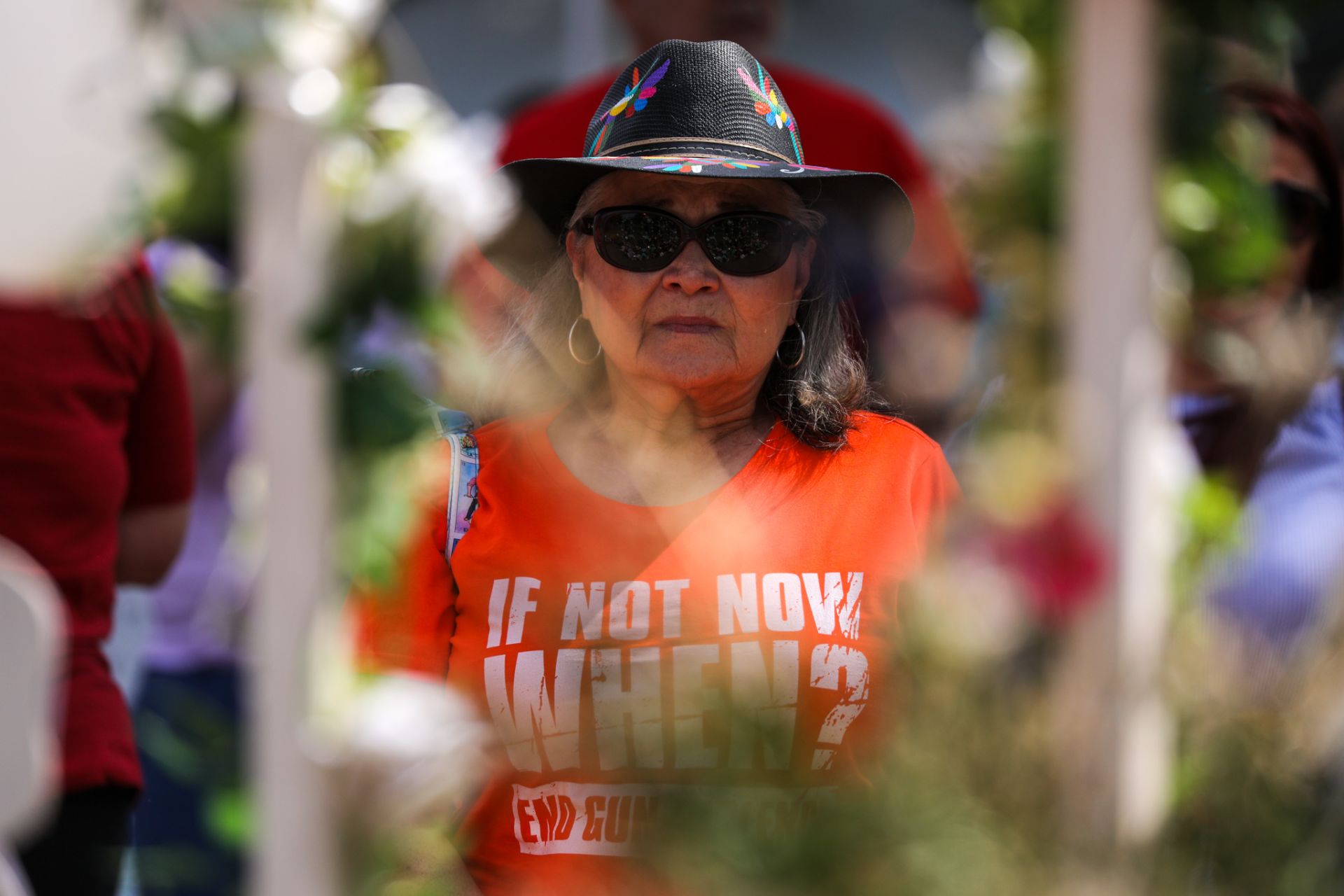
The sparrow that had alighted on the wall was full of avian vitality. It chirruped as it scanned the sky full of brightly colored kites. Its feathers ruffled in a breeze fragrant with the scent of orange blossom. Springtime in Peshawar is full of exuberance, a welcome respite between harsh winters and infernal summers. The city is alive with birdsong.
I noticed none of this as I stared at the bird through the sight of my pump-action air rifle. All I could see was an elusive trophy. I was 11. I had been handling guns since I was much younger. Back in my hometown, my not-always-responsible father had let me carry my own, a folding-stock AK-47 assault rifle. At weddings, I would take my turn with Afghan mujahedeen shooting at static targets. It was the late 1980s, and Chitral in northwest Pakistan was home to many Afghans, a staging post for their operations across the border in Kunar. The place was awash in guns, from cheap Chinese knockoffs to finely crafted German assault rifles. I became an enthusiast. I could dismantle my Kalashnikov and put it back together with my eyes closed.
But unlike my brother, who was a first-rate hunter, I was a failure at the game. I could never hit anything that moved. That is, until the day I saw the sparrow on the wall. I pulled the trigger, and the sparrow toppled over. I had finally scored. But my sense of triumph lasted only the few seconds it took me to reach the bird. The pellet had broken its leg, which was dangling on the side. The bird was in shock, its wings flapping listlessly. I picked it up and felt it struggle in my hand. I had seen plenty of dead game: I had even had “pakoras” (spicy fritters) made of sparrows in Peshawar’s Namak Mandi bazaar. I probably wouldn’t have given a dead bird a second thought. But this one was suspended between life and death, and each quiver of its body made me more conscious of the life that was ebbing away.
I had never felt so small. I bandaged the bird’s leg with a strip of Scotch tape and tossed it into the air. It flew away, heavy and languid. That was the last time I fired a gun. It was the end of my fascination.
In the 1980s, Pakistan’s northwest had been transformed by the war next door in Afghanistan. Unlike the rest of Pakistan, with its feudal hierarchies, the northwest is egalitarian and unruly. People prize their autonomy, and every home has a gun. But before the Afghan war, the gun served mostly a symbolic function: more a defensive necessity than an actual instrument of violence. All we had at our home was a .303-caliber, Lee Enfield rifle and my grandfather’s sword.
But things changed in the 1980s. As guns became freely available, their display became as important as their possession. Public events turned into veritable gun shows. Celebratory gunfire at weddings or childbirth was always a tradition. But it now became a competition — for the loudest, biggest, fastest gun. Even the shooting became more ostentatious. At one wedding, a man accidentally killed both bride and groom when the muzzles of the two AK-47s he had raised on each shoulder dropped on recoil and sprayed the stage with bullets. Deaths from stray bullets became common. My sister was hit by a falling bullet as she sat on her college lawn. A bullet from a neighborhood wedding hit the wall just above our heads one evening as we sat on a friend’s terrace. At one wedding I attended, the gunfire cut the electricity lines.
We didn’t have mass shootings, but the gun culture was a menace. Every sporting victory, every childbirth, every wedding celebration could mean grief to someone else. This culture persisted into the decades after the end of the anti-Soviet jihad. Outside of the tribal areas, where the law offered you little protection and weapons were a necessity, guns were a symbol of status and power. They were to a man what jewelry is to a woman. Ironically, they became less visible when a real threat emerged in the mid-2000s with the rise of the Pakistani Taliban. In the mortal combat between the Pakistani Army and this ruthless new force, there was no room for a third party with guns. But as this threat subsided, men have returned with their lethal jewelry. On New Year’s Eve in Karachi, an 11-year-old was killed and 17 injured in celebratory gunfire.
I’ve been away from the country for two decades. On my first Guy Fawkes Night in Glasgow, in 2004, when fireworks lit the sky, I did not have to hurry indoors as I would have in Pakistan at the sound of explosions. This event was joyous, it didn’t externalize the cost of celebration to others. But — to paraphrase Joseph Conrad — this, too, had been a place of darkness. For the past eight years, on the drive to work, I’d exit the M9 highway toward Stirling University at the roundabout near Dunblane. It is impossible to look at this picturesque Scottish idyll and connect it with one of Britain’s most traumatic events.
On the morning of March 13, 1996, a 43-year-old gunman had entered the Dunblane Primary School and killed 16 children and a teacher, injuring 15 others. The man was carrying four handguns — two Browning Hi-Power pistols and two Smith & Wesson Model 19 revolvers — all purchased legally. The massacre horrified the country and united both major parties. Following an official inquiry, the Conservative government of Prime Minister John Major introduced the Firearms (Amendment) Act 1997, which banned virtually all citizens from owning guns; a year later, Tony Blair’s Labour government expanded the ban to also include.22-caliber, single-shot weapons. There have been no school shootings in the U.K. since, and Dunblane today is better known as Andy Murray’s hometown. (The two-time Wimbledon champion was an 8-year-old pupil at the Dunblane Primary School at the time of the massacre.)
Six weeks after Dunblane, Australia, too, was struck by tragedy when a 28-year-old went on a rampage in Port Arthur, killing 35 and injuring 23. Two children, aged 3 and 6, were killed along with their mother, execution style. The defense psychologist claimed that the shooter had been inspired by the notoriety of the Dunblane killer. The Australian government, however, needed no foreign inspiration. Prime Minister John Howard’s Conservative government was even quicker than Britain’s in introducing highly restrictive gun laws, passing the National Firearms Agreement within 12 days of the massacre, buying back 650,000 guns within a year. Howard defied his own base and Australia’s gun lobby, which was being secretly supported by the National Rifle Association (NRA) and the Christian Coalition to mobilize Australians against the restrictions. The measures proved effective enough that in the years since, there have been no mass shootings (some have tried to define incidents of family homicide as a “mass shooting” to downplay Australia’s success). The numbers of suicides and homicides also dropped. There were 521 deaths from firearms in 1996; by 2019, the number had fallen to 219.
So successful was this policy that two decades later, when an Australian terrorist resolved to kill a large number of Muslims, he had to move to New Zealand to enact his plot. On March 15, 2019, the 28-year-old shooter shot and killed 51 worshippers and injured 40 at two mosques in Christchurch. The six guns he used were all legally purchased. A week later, Prime Minister Jacinda Ardern announced a ban on semi-automatic weapons, and, on April 10, the Arms (Prohibited Firearms, Magazines, and Parts) Amendment Act 2019 was passed by the New Zealand Parliament with support from all parties except one.
A year later, in April 2020, a 51-year-old Canadian dressed as a police officer went on a killing spree through rural Nova Scotia, killing 22 before being killed himself by the police. Three of the four guns he used had been smuggled from the U.S. But within two weeks, Prime Minister Justin Trudeau had announced a ban on assault weapons.
From Britain to Australia, New Zealand and Canada, mass atrocities have been followed by public outrage and political action. The responses were rational, necessary, inexorable. The link between a public issue and political action seemed obvious. But even as the U.S. mourns the victims in the most recent of its painfully frequent mass atrocities, the grief feels enervated by the certainty of inaction. Even the angriest seem resigned to the fact that a country that could live with the killing of 10 people at a supermarket in Buffalo, New York, 10 days earlier can also live with the murder of 19 children and two teachers at a primary school in Uvalde, Texas. Republicans — the main obstacle to political action on guns — require the bereaved to be content with “thoughts and prayers.” Those who fail are accused of making the tragedy “political.”
“Now is not the time for politics,” they say. But given the frequency of mass shootings in America, where every “now” is preceded by tragedy, this precludes any political action lest it profane the moments whose solemnity the Republicans are eager to preserve. The debate has a theological quality, and its presiding deity is Moloch, the malign God from the Old Testament to whom children were sacrificed in fire. The analogy was used to describe America’s consecrated gun by historian and classicist Garry Wills in the aftermath of the Sandy Hook massacre. Wills was perhaps resorting to an emotive reference because with all his careful reasoning and prodigious knowledge, he had failed to penetrate the wall of unreason that surrounds the gun debate.
In a September 1995 essay for the New York Review of Books, Wills had eviscerated the emerging body of scholarship from a group of lawyers, historians and criminologists interpreting the Second Amendment as guaranteeing the right to private ownership of guns. Wills had used etymology, historical context and legal exegesis to show that the amendment guaranteed people’s right to “keep and bear arms” only in a military context, as part of a “well-regulated militia.” But when the Supreme Court dealt a blow to gun reform in District of Columbia v. Heller (2008), for the first time interpreting the Second Amendment as protecting individuals’ rights to possess firearms, the conservative justices drew on the same revisionist scholarship that Wills had criticized.
This has added to the already considerable obstacles to sensible action on guns. A year earlier, the Clinton administration had introduced a 10-year assault weapon ban, which coincided with a fall in murder rates and, according to a 2019 New York University School of Medicine study, saw a 70% decline in mass shootings. But in 2004, the Bush administration allowed the ban to lapse, and the number of mass shootings tripled in the following decade. Things got even worse. According to data collected by the Gun Violence Archive, 2,858 children were affected by gun violence in 2014; the number had risen to 5,692 by 2021. According to the FBI, there were three active shooter incidents in 2000; by 2020 there were 40. (“Active shooter” incidents are only a small fraction of America’s overall firearm deaths, which last year totaled 20,920.)
America today has more guns than there are people, and over half of the guns are owned by just 3% of the population. There is a direct correlation between levels of gun ownership and gun violence, a statistic that holds true within and beyond the U.S. And states with relaxed gun laws have higher incidences of mass shootings, a 2019 BMJ study found.
It all seems obvious. Why the inaction?
It is doubtful that the resistance to regulation by a milksop like Ted Cruz or a sybarite like Donald Trump is based on an unusual devotion to firearms. Even the NRA’s millions don’t fully explain the resilience of the GOP’s opposition to sensible gun laws. But gun possession has become a vector in the culture wars, the racialized politics from which the GOP has historically benefited. It is unlikely to cede this advantage. Republicans exploit resentments by railing against the “elite” who are out to rob law-abiding citizens of their means of self-defense, while simultaneously pathologizing the violence, blaming mental illness for it.
After the Uvalde tragedy, Republican Texas Gov. Greg Abbott claimed the shooter had a “mental health challenge” and suggested that greater investment in mental health could address the crisis. It is possible that he genuinely believes mental illness leads to mass shootings and is committed to addressing this. But as Abbott had to acknowledge, the killer had no history of mental illness or a criminal record. And more broadly, an FBI analysis of 63 active shooter incidents from 2000 to 2013 found that mental illness was diagnosed in only a quarter of the killers; only three were known to have a psychotic disorder. There is reason to doubt Abbott’s commitment to mental health since just last April, he had cut $211 million from the department that oversees the state’s mental health programs. His state ranks last in the U.S. for access to mental health care.
Stigmatizing mental illness, calls for arming teachers, demands to fortify schools have all been used as deflections by the GOP. Yet, despite having facts on their side, Democrats have made little progress. In contenting themselves with rational arguments, they have allowed the GOP to control the narrative with emotional appeals to their base. For any change to occur, Democrats must get more confrontational and seize the narrative. They’ll have to stop making concessions to the Republican framing about America’s supposedly unique culture and history. But more important, Democrats will have to address their broader weakness and learn to wield power. Because when politics changes, so does culture.
America’s love of guns is not unique, unlike its gun culture. The pathology is not so much the perpetrator’s mind as a culture that sees the possession of an assault rifle as something so unexceptional that it shouldn’t even require a background check. In most places, including the country where I grew up, the culture changed with changes in politics. One day when America has finally had enough and the government outlaws combat weapons, even the most committed gun owner will adjust to the new reality, as Brits, Aussies, Kiwis and the Canucks did before them. They’ll discover that they are far more secure surrendering the assault weapons they kept for a hypothetical threat than to use them and be confronted with a real one: the might of the world’s most powerful state.
There is nothing fixed about culture. Cultures evolve; traditions are abandoned. Many once-cherished traditions are abhorrent to us today. It is a measure of our moral evolution. In the end, it is a spell cast over us, through socialization or propaganda, suppressing thoughts, turning actions into reflexes. It can be broken. In Peshawar, I shot a bird thoughtlessly, because it is what boys did. Until then, a gun had felt integral to my identity. But the incident led to an epiphany: A world without the rapport of guns is infinitely more livable than a world without birdsong. Given the link between the easy availability of guns and the proliferation of school shootings, Americans, too, will have to decide what they prize more: the crackle of gunfire or a schoolyard’s rhapsody.
Germany plans to tighten gun control
The German government is planning to make background checks for potential gun owners even tighter. But questions remain over whether authorities are even equipped to carry out such controls.
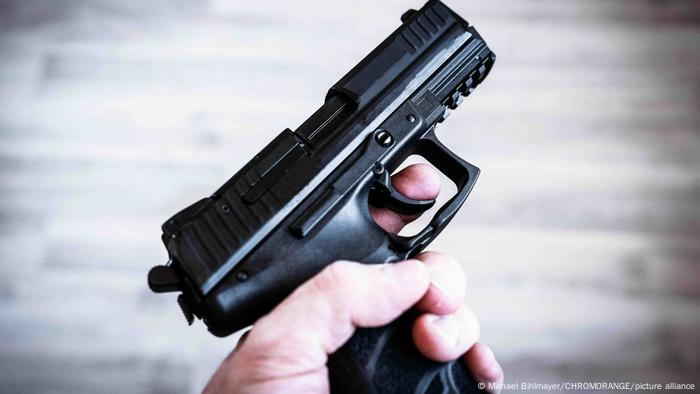
One million people in Germany own a total of five million firearms
The German government is seeking to impose even stricter background checks on gun ownership in an attempt to prevent political extremists and the psychologically disturbed from buying guns.
The latest call for restrictions comes partly in response to the killings in Hanau in February 2020, when a racist attacker Tobias R.* murdered nine people of color before killing his mother and himself.
He was able to buy guns legally even though he had been diagnosed with paranoid delusions in 2002 when he told police he was being spied on and "psychologically raped" through the power outlets in his walls. Tobias R. legally owned three guns at the time of the killings, and was able to borrow another from a gun trader.
In a statement to DW, an Interior Ministry spokeswoman confirmed that a draft bill is currently being drawn up, whose intention is to expand the scope of the background checks authorities can and must make before granting or renewing a gun license.
Mental illness and gun ownership
Around one million people in Germany legally own a total of more than five million firearms. Most of them are sport shooters, hunters, or foresters. Though gun violence is relatively rare in Germany, an average of 155 people are killed by gunfire every year.
Marcel Emmerich, a member of parliament for the Green Party and domestic policy spokesman, is convinced that recent incidents show that Germany's rules for gun ownership need to be restricted further. "Fewer weapons being privately owned means more public safety," he said.
The government's plans include requiring authorities that grant gun ownership licenses — often the relevant state police — to check with health authorities whether applicants have a record of mental illness.
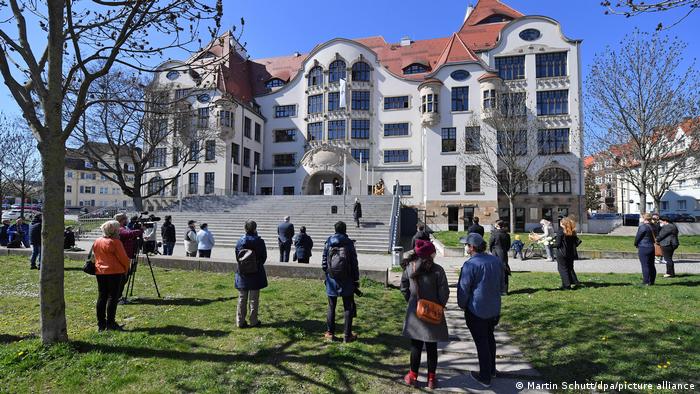
A 19-year old who legally owned a gun, shot 16 people at his school in Erfurt in 2002
But the issue of mental illness raises several problems, according to Dietmar Heubrock, professor of forensic psychology at Bremen University, and once an expert witness on gun control for the German parliament. Health authorities don't necessarily have complete records on mental illness, he argues, and no database can cover the variety of psychological issues that could lead to violence. "Do we even have the right procedures to recognize the potential psychological dangers that might develop in later life?" he said.
"Let's say I already own a gun and then hit a personal crisis — my livelihood gets taken away, and I start developing violent fantasies: I want to avenge myself on society, and I want to go out and kill everyone I see," he tells DW. "No health authority would know about that."
The solution, according to Heubrock, is developing new psychological tests that each applicant for a gun ownership card would have to pass. "The current tests are 20 years old, and any test, whether it's an intelligence test or a personality test, has to be re-standardized after a time," he explains.
Green Party MP Emmerich agrees, saying that the new law could, for instance, require all applicants to pass a psychological assessment test — not just those under the age of 25, as the law demands now.
But the German Shooting Sport and Archery Federation (DSB), which numbers some 1.3 million members, doubts whether gathering sensitive health data will be legally viable and whether anyone without medical expertise is qualified to interpret it properly.
"For example, an official in a regulatory authority can surely not judge whether an entry in a health file is even relevant to weapons law," DSB spokesman Thilo von Hagen told DW in an email.
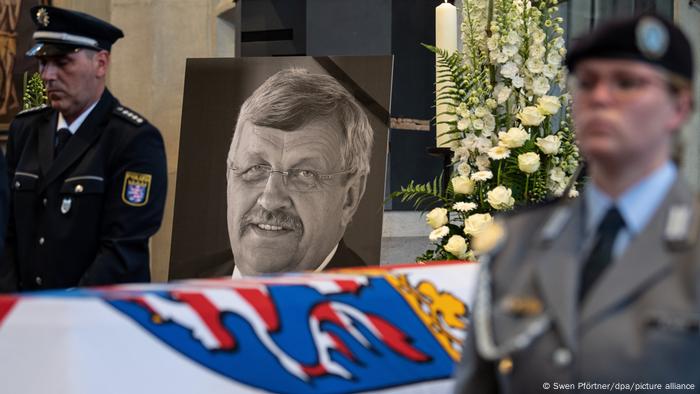
Politician Walter Lübcke was shot and killed by a neo-Nazi who had been a member of a gun club
Several amendments to gun law
Germany has consistently tightened gun laws following mass shootings. Age limits for gun ownership were raised following a school shooting in Erfurt in 2002, and random spot checks on gun owners, to ensure they were storing guns according to regulations, were introduced following a mass shooting in the town of Winnenden in 2009.
Following terror attacks in Paris in 2015, the EU amended its firearms directive, which was incorporated into German law in 2020, the last amendment to date. Since then, the firearms authorities have been obliged to check with the domestic intelligence agency whether an applicant is known to them as an extremist.
Since 2020, authorities are also obliged to check every five years whether registered German gun owners have a legitimate "need" to own a gun: In practice, that often means police will check whether the gun owner is still a member of a shooting club or has a hunting license.
But there have been reports of neo-Nazis joining shooting clubs, and Germany has been shocked in recent years by stories of so-called Reichsbürger (conspiracy theorists who believe the Federal Republic of Germany is not a legitimate state) hoarding firearms. Two recent far-right perpetrators, the Hanau perpetrator Tobias R., and Stephan E., the neo-Nazi who murdered a local governor Walter Lübcke in 2019, both joined shooting clubs.
Gun owners in Germany see no need for more regulations. Torsten Reinwald, the spokesman for the German hunting Association (DJV), which represents some 250,000 registered German hunters, says the problem is the implementation of current laws, rather than the laws themselves.
"Hanau could have been prevented," Reinwald tells DW. "The facts were on the table: It was known that this person was mentally ill, but no action was taken. If the authorities had been better connected, this person could've been pulled out of circulation. That's the basic problem. To make new demands now — they're just 'placebos,' nothing more."
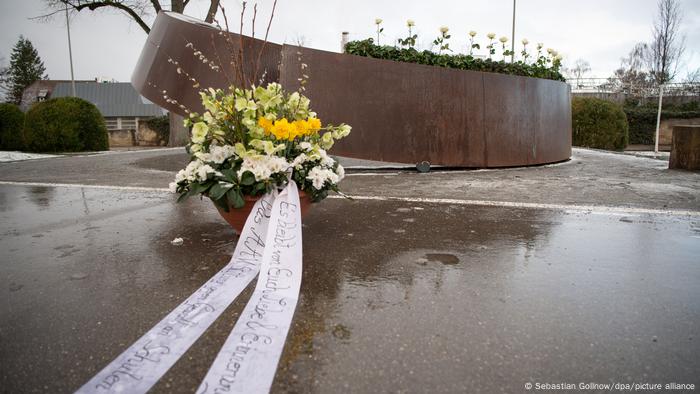
In 2009, a 17-year-old stole his father's gun and killed 15 people in Winnenden
Personal freedom, privacy, and privilege
Authorities already have relatively wide-ranging powers to check gun owners: If they have any suspicions about applicants, they can require an additional health certificate. Reinwald says police spot checks are already "a severe intrusion in personal freedom."
Another concern is privacy. The neoliberal Free Democrats (FDP), the government party most sensitive to personal freedom issues, has already flagged concerns over the Interior Ministry's plans.
Green Party MP Emmerich acknowledges that medical data is "highly sensitive," but added that this will be considered in any new law. "The challenge is handling data responsibly, but also ensuring that certain people don't get their hands on weapons," he said.
Historian Dagmar Ellerbrock from the Technical University of Dresden told Deutschlandfunk public radio that in her view the debate on restrictions was misleading: Owning a gun, she said, is not a basic right that is now being restricted by law. "It's a privilege," she said. "A privilege granted to certain people. And whoever wants to be granted this privilege has to qualify for it."
*DW follows the German press code, which stresses the importance of protecting the privacy of suspected criminals or victims and urges us to refrain from revealing full names in such cases.
Edited by: Rina Goldenberg
If you are suffering from serious emotional strain or suicidal thoughts, do not hesitate to seek professional help. You can find information on where to find such help, no matter where you live in the world, at this website: https://www.befrienders.org/
'This time is different': Tens of
thousands protest gun violence
in US
At rallies held across the US, protesters made it clear to politicians they want better gun control. DW was at the Washington march, where a false alarm scattered the crowd and pro-gun demonstrators were escorted away.

Protesters were sick of 'thoughts and prayers' after each mass shooting
"As we gather here today, the next shooter is already plotting his attack while the federal government pretends it can do nothing to stop it," David Hogg, a survivor of the Stoneman Douglas High School shooting, told a crowd of tens of thousands in the US capital, Washington, on Saturday.
The event, which featured speeches from other survivors, the families of victims and educators, drew an estimated 50,000 attendees, according to the organisers, March for Our Lives. The group was founded by Hogg and other children from the school in Parkland, Florida, to advocate for stricter gun control.
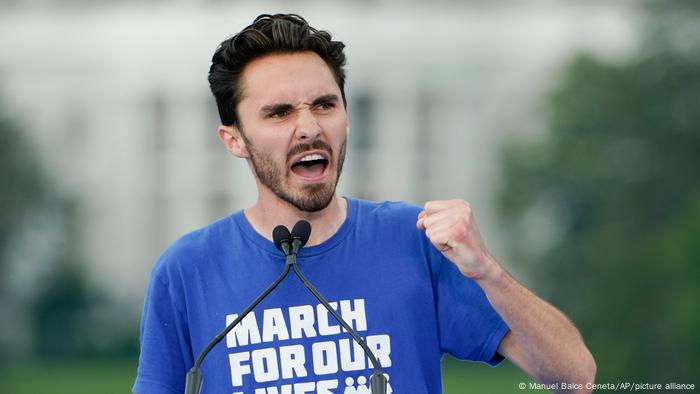
Parkland shooting survivor, David Hogg, said the killings of children in Uvalde 'should fill us with rage'
Addressing the crowd near the Washington Monument, he urged the crowd to imagine seeing the name of a loved one appear on the ever-growing list of gun violence victims in the US.
"This time is different," Hogg said, before asking the crowd to chant the sentence repeatedly.
Simultaneous protests look place in around 450 locations across the US, calling for an end to inaction from political leaders.
The marches followed deadly mass shootings in Uvalde, Texas, where a gunman killed 19 children and two teachers, and a supermarket shooting in Buffalo, New York, that left 10 people dead, as well as a shooting at a Taiwanese-American church in Southern California, in which one person was killed and five injured. All those events took place within one month.
"I speak as a mayor, a mom, and I speak for millions of Americans and America's mayors who are demanding that Congress do its job. And its job is to protect us, to protect our children from gun violence," Mayor Muriel Bowser told protestors in Washington. "Enough is enough.''
Re-living the fear
During a moment of silence held for the Uvalde shooting victims, a loud voice pierced through the calm, causing panic among the crowd. People in the front reported hearing the word "gun" and dozens ducked to the ground, while others fled in fear.
"I saw other people running, and people telling others to run. So I ran," Milton Gardner, a 23-year-old student at Virginia Commonwealth University, told DW. "It gave me a flash of how … every second of the day is a risk in this country, no matter where you are and what you are doing."
Gardner added that he had been afraid to even attend the rally after the Buffalo shooting.
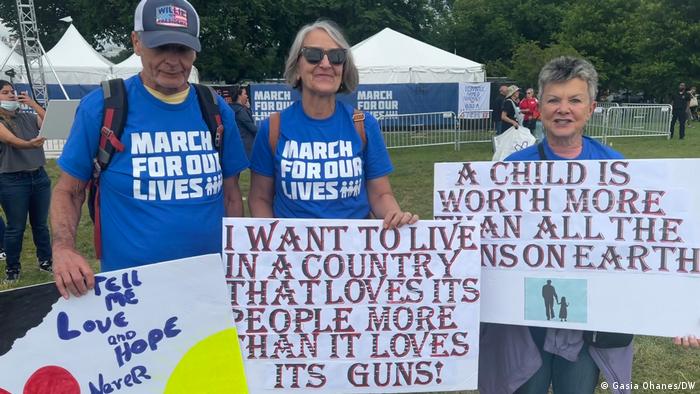
Teacher Margaret Tice (middle) was shocked by a false alarm in the middle of the protest
"Everybody hit the ground and I was just standing there because I was in shock," said Margaret Tice, a 63-year-old teacher from West Virginia.
"This woman in front of me broke down and she was sobbing on the ground. It’s real. People are fearful of that every day," she added.
A man obscuring his his face with a US flag scarf and dark sunglasses sparked fury by unfurling a large banner reading “Guns'n'bacon.”
March for Our Lives supporters quickly blocked the banner from view with their signs calling for gun control, before the man was escorted away by police.
Stephanie Birch, a university librarian, covered the word “guns” on the banner with black tape.
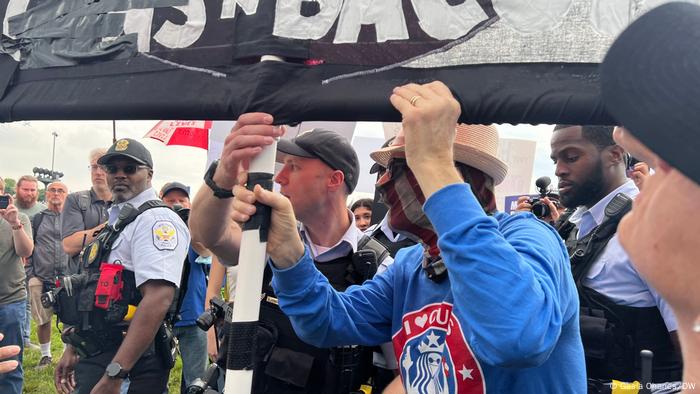
A man holding a pro-gun placard is led away from the protest by police
"When you have a protest you can expect agitators," the 33-year-old, who flew to the protest from Florida, told DW. “Fortunately there was no violence, and he had no gun. I think that’s something a lot of us have been worried about — the possibility of a shooting happening here today.”
House passes new gun controls, but Senate holds out
On Wednesday, the Democrat-controlled House of Representatives passed a sweeping set of gun safety measures, but the legislation has little to no chance of advancing in the Senate, where Democrats would need the support of 10 Republicans for the requisite super majority.
Republicans there believe gun limits violate the US Constitution's Second Amendment, the right to bear arms.
At the Washinton rally, Hogg led the crowd in chants of "vote them out," referring to Republican politicians.
"This time is different because this isn't about politics. It's about morality. Not right and left, but right and wrong, and that doesn't just mean thoughts and prayers. That means courage and action," Yolanda King, granddaughter of Martin Luther King Jr., said.
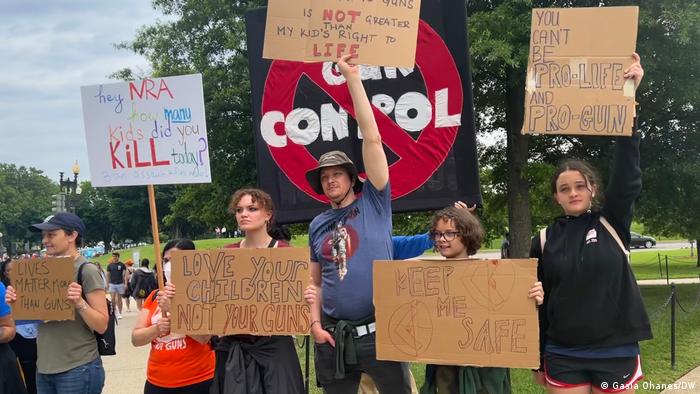
Protesters like Rebecca Toronto (far right) and her family blocked pro-gun placards at the march
Rallies also took place in Atlanta, New York, Los Angeles and Chicago.
In New York, the state's Attorney General Letitia James, who is suing gun lobby group, the National Rifle Association, joined activists crossing the Brooklyn Bridge.
"Nothing happens in this country until young people stand up, not politicians,'' James said.
Hundreds gathered at an amphitheater in Parkland, where Debra Hixon, whose husband, high school athletic director Chris Hixon, died in the Buffalo shooting, said it is "all too easy'' for young men to walk into stores and buy weapons.
President Biden 'mildly optimistic' about reform
President Joe Biden backed the protests, urged demonstrators to "keep marching" and added that he was "mildly optimistic" about legislative negotiations to address gun violence.
A bipartisan group of Senators had hoped to reach an agreement this week on a framework for addressing the issue and held talks Friday, though they have yet to conclude a deal.
March For Our Lives has called for an assault weapons ban, universal background checks for those trying to purchase guns, and a national licensing system that would register gun owners.
At the same time, opponents of tougher regulations have sought to cast mass shootings as primarily a mental health issue, not one of access to firearms.
More than 19,300 people have died in gun-related incidents in the US so far this year, according to the Gun Violence Archive. More than half of those deaths are due to suicide.
lo/msh (AP, AFP, Reuters)

No comments:
Post a Comment